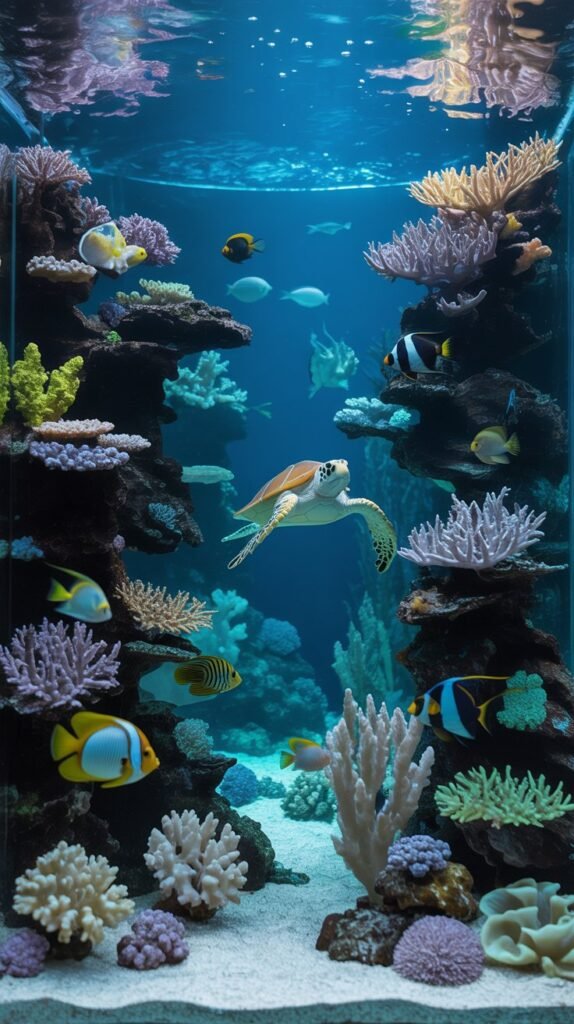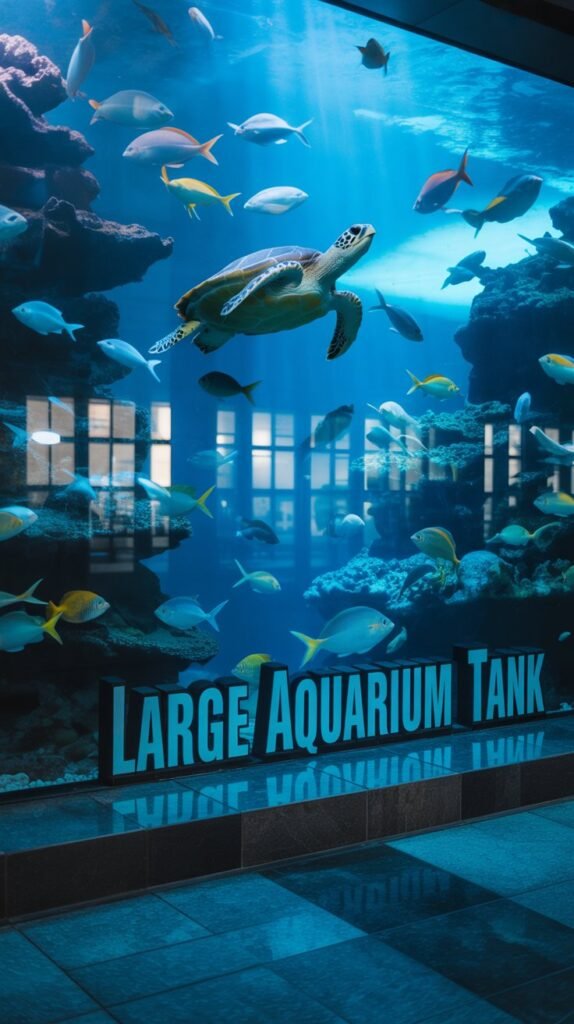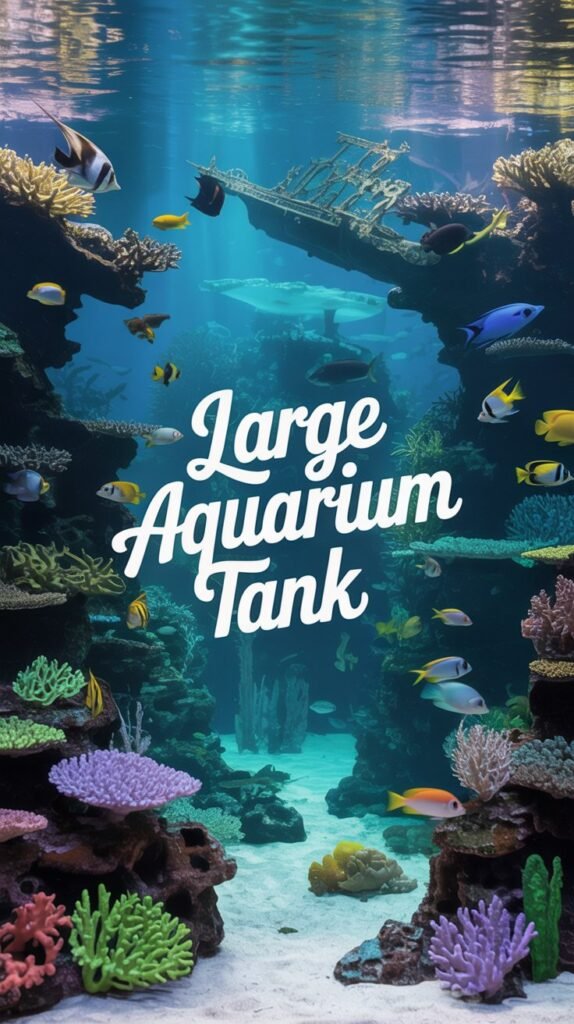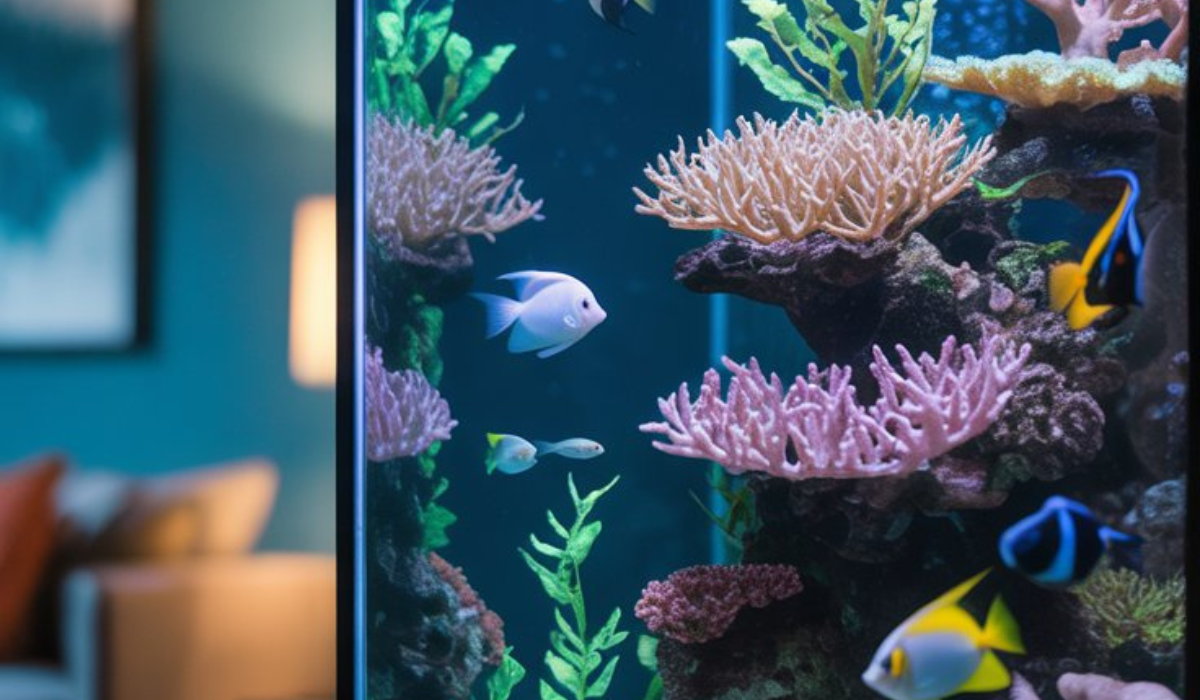A large aquarium tank can transform any room into a captivating underwater world. Whether you’re an experienced aquarist or planning your first big tank, setting up a large aquarium is both exciting and rewarding. Bigger tanks provide more stability, creative flexibility, and the opportunity to keep larger or more diverse aquatic species. However, they also require careful planning, proper equipment, and regular maintenance to thrive.
In this comprehensive guide, we’ll cover everything you need to know about large aquarium tanks — from choosing the right size and materials to setup, filtration, stocking, aquascaping, and long-term care.
🌊 What Is Considered a Large Aquarium Tank?
An aquarium tank is typically considered large when it holds 75 gallons or more of water. Common large aquarium sizes include:
- 75 gallons (48″ x 18″ x 21″)
- 90 gallons (48″ x 18″ x 24″)
- 125 gallons (72″ x 18″ x 21″)
- 150 gallons (72″ x 18″ x 28″)
- 180 gallons (72″ x 24″ x 25″)
- 220 gallons and beyond
Large tanks can be custom-built to fit unique spaces, offering endless possibilities for design and fish selection.
🐠 Advantages of a Large Aquarium Tank

While larger tanks require more investment and effort, they also offer significant benefits:
1. Greater Water Stability
Large water volumes dilute toxins such as ammonia and nitrite more effectively, providing a more stable environment for fish. Temperature and pH fluctuations are also minimized.
2. More Space for Fish
Bigger tanks allow fish to swim freely and exhibit natural behaviors. You can keep larger species or mixed communities that wouldn’t fit in smaller tanks.
3. Enhanced Aquascaping Possibilities
A large tank gives you the creative freedom to build stunning aquascapes with live plants, rocks, driftwood, and other decorative elements.
4. Easier Maintenance Over Time
Although setup is complex, large tanks are easier to maintain once established. The water parameters remain more consistent, reducing stress on fish.
5. Impressive Aesthetic Appeal
A big aquarium can become a breathtaking centerpiece in a home, office, or public space. It adds tranquility, color, and life to any environment.
🧱 Choosing the Right Type of Large Aquarium Tank
Large aquarium tanks come in different materials and designs. Understanding their pros and cons helps you make the best choice for your needs.
1. Glass Aquariums
Glass is the most common material for large tanks.
Pros:
- Scratch-resistant and durable
- Crystal-clear visibility
- Affordable for standard sizes
Cons:
- Heavy, especially in large sizes
- Can crack or shatter under impact
Best For: Home aquariums, freshwater and saltwater setups
2. Acrylic Aquariums
Acrylic is lighter and more flexible than glass, making it ideal for very large or custom tanks.
Pros:
- Lightweight and easy to move
- Can be molded into curved or panoramic shapes
- Better insulation — keeps water temperature stable
Cons:
- Prone to scratches
- More expensive than glass
Best For: Custom designs, public aquariums, reef tanks
3. Custom-Built Aquariums
For tanks over 300 gallons, custom designs are often necessary. They allow complete control over dimensions, filtration systems, and materials.
Pros:
- Tailored to fit space and design preferences
- Supports unique setups (wall tanks, room dividers, etc.)
Cons:
- Expensive and time-consuming
- Requires professional installation
🧰 Essential Equipment for a Large Aquarium Tank

Setting up a big tank requires high-quality and powerful equipment to maintain stability and cleanliness.
1. Filtration System
A strong filtration system is crucial. You’ll need a canister filter, sump filter, or both to handle the large water volume.
- Canister filters offer excellent mechanical, biological, and chemical filtration.
- Sump filters provide large filtration capacity and space for heaters, skimmers, and reactors.
Tip: Choose a filter that can process at least 5–6 times the tank’s total volume per hour.
2. Heater and Thermometer
Large tanks need consistent heating to maintain stable temperatures. Use multiple heaters distributed evenly across the tank.
Recommended Temperature Range:
- Freshwater fish: 74–80°F (23–27°C)
- Saltwater fish: 76–82°F (24–28°C)
3. Lighting System
Lighting affects plant growth, coral health, and overall aesthetics.
- LED lights are the best option for large tanks due to efficiency and customization.
- Fluorescent or metal halide lights can be used for deep aquariums or reef tanks.
Tip: Use a programmable lighting system to mimic natural day/night cycles.
4. Air Pumps and Powerheads
Proper water circulation is vital in large tanks to prevent dead zones and ensure oxygenation. Powerheads and air pumps help distribute heat and nutrients evenly.
5. Substrate and Decorations
Choose substrate (gravel, sand, soil) according to your aquarium type. Use rocks, driftwood, and artificial or live plants to enhance natural beauty.
6. Stand and Support
A filled 100-gallon tank weighs over 800 pounds (360 kg) — so it needs a sturdy stand. Always ensure your flooring and furniture can handle the load.
🪴 Aquascaping Ideas for Large Aquariums
Large tanks allow incredible design creativity. Here are a few aquascaping styles:
1. Nature Aquarium
Inspired by natural landscapes — rivers, forests, or mountains — this style uses driftwood, stones, and live plants to mimic real ecosystems.
2. Dutch Style
Focuses on lush, colorful plant arrangements without hardscape dominance. Perfect for freshwater setups.
3. Biotope Aquarium
Replicates a specific natural habitat (Amazon, African Rift Lake, etc.), including native fish, plants, and substrates.
4. Reef Aquarium
Designed for saltwater enthusiasts — features live rock, corals, and marine fish.
5. Minimalist Style
Clean lines, limited decor, and open spaces emphasizing fish movement and lighting effects.
🐟 Best Fish for Large Aquariums

A large tank opens the door to keeping larger or more diverse species. Here are some great options:
Freshwater Options:
- Oscar Fish — Intelligent and territorial; need space.
- Arowana — Elegant, large predators for advanced keepers.
- Angelfish and Discus — Beautiful and peaceful schooling fish.
- Clown Loaches — Active bottom dwellers.
- Plecos and Catfish — Great for algae control.
Saltwater Options:
- Tangs and Surgeonfish — Active swimmers that need room.
- Clownfish — Popular and hardy.
- Wrasses — Colorful and energetic.
- Gobies and Blennies — Perfect for reef tanks.
- Lionfish — Striking but predatory; for experienced aquarists.
🧼 How to Set Up a Large Aquarium Tank (Step-by-Step)
Step 1: Choose the Location
Pick a stable, level area away from direct sunlight, heaters, or air vents.
Step 2: Install the Stand and Tank
Make sure the stand can handle the tank’s full weight. Use a spirit level to ensure even placement.
Step 3: Add Substrate and Decorations
Rinse the substrate before adding it. Arrange decor to allow fish hiding spots and good water flow.
Step 4: Install Equipment
Set up the filter, heater, air pump, and lighting system. Check for leaks before filling completely.
Step 5: Fill the Tank
Use dechlorinated water for freshwater or pre-mixed saltwater for marine tanks. Fill slowly to avoid disturbing the substrate.
Step 6: Cycle the Tank
Perform a nitrogen cycle for 4–6 weeks before adding fish. This process establishes beneficial bacteria to handle fish waste.
Step 7: Add Fish Gradually
Introduce fish slowly, allowing the ecosystem to adjust to the bioload. Avoid overcrowding early on.
🧽 Maintenance Tips for Large Aquarium Tanks
Keeping a large aquarium clean is easier with a consistent schedule:
- Weekly Tasks:
- Check temperature, pH, and ammonia levels.
- Top off evaporated water.
- Wipe glass and check filter flow.
- Biweekly Tasks:
- Perform 20–30% water changes.
- Vacuum substrate to remove detritus.
- Monthly Tasks:
- Clean filter media (rinse in old tank water).
- Inspect equipment and replace worn parts.
- Every 3–6 Months:
- Deep clean decorations.
- Prune plants and rearrange if needed.
⚠️ Common Mistakes to Avoid
- Overcrowding the tank with too many fish.
- Skipping the nitrogen cycle.
- Using an undersized filter.
- Overfeeding fish — leads to water pollution.
- Neglecting regular water changes.
- Placing the tank near direct sunlight (causes algae bloom).
🏡 Display and Placement Ideas
Large aquariums can be showpieces in:
- Living rooms (wall or corner setups)
- Office reception areas
- Restaurants and hotels
- Wall partitions or built-in cabinetry
Lighting Tip: Add background lighting or LED strips for dramatic visual appeal.
💰 Cost Considerations
Setting up a large aquarium can be a major investment. Here’s a rough cost estimate:
| Item | Estimated Cost |
|---|---|
| Large Aquarium Tank (100–200 gal) | $400–$2,000+ |
| Stand or Cabinet | $150–$800 |
| Filtration System | $150–$500 |
| Heater & Lighting | $100–$500 |
| Substrate & Decor | $100–$300 |
| Fish & Plants | $100–$600 |
| Maintenance Supplies | $50–$150 |
Total Estimated Setup: $1,000–$4,000+ depending on size and customization.
✅ Conclusion
A large aquarium tank offers endless beauty, serenity, and the chance to create a thriving aquatic world. While the setup requires planning, proper equipment, and commitment, the rewards are unmatched. From stunning aquascapes to diverse fish communities, large tanks bring nature indoors in the most spectacular way possible.
Whether you’re creating a freshwater paradise or a saltwater reef, success comes from patience, knowledge, and consistent care.
❓FAQs About Large Aquarium Tanks
Q1. What size tank is considered large?
Any aquarium over 75 gallons is generally considered a large tank.
Q2. How much does a large aquarium weigh?
A 100-gallon tank can weigh around 800–1,000 pounds when filled with water and decorations.
Q3. Are larger aquariums easier to maintain?
Yes — larger tanks maintain more stable water parameters, making them easier to manage once established.
Q4. Can I keep saltwater fish in a large tank?
Absolutely. In fact, large tanks are ideal for saltwater setups since they provide room for live rock, corals, and marine species.
Q5. How many fish can I keep in a large tank?
It depends on fish size and species. Follow the “one inch of fish per gallon” rule as a starting point, but always research species compatibility.
Q6. Do large aquariums need special flooring support?
Yes — ensure your floor can support the tank’s full weight. Consult a professional if unsure.
Q7. How long does it take to cycle a large tank?
Typically, 4–6 weeks are needed to establish beneficial bacteria before adding fish.

